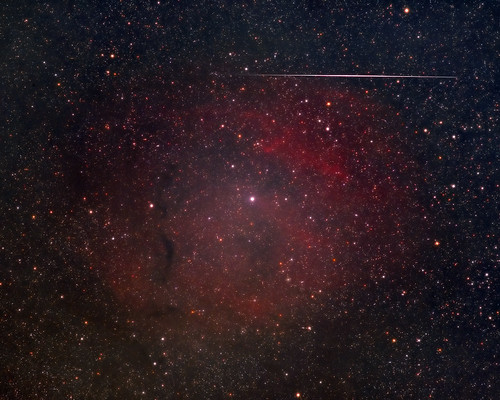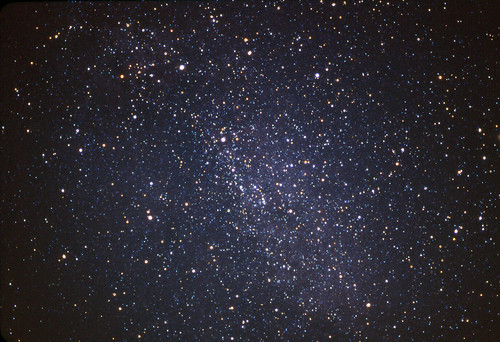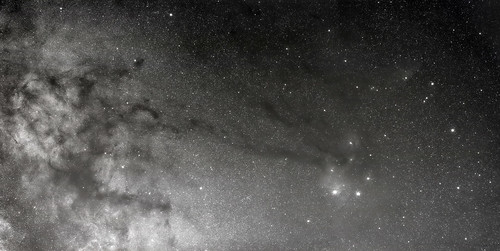Sharpless 2-27 is very large nebula centered around Zeta Ophiuchi. Very difficult to photograph due to its size and brightness, it is over twenty Moon diameters wide and very faint. Film and detectors well equipped for Hydrogen-Alpha (Ha) imaging reveal it best. I consider it one of the greatest objects in the Milky Way.
Located on the Milky Way's border in Southern Ophiuchus and partially overlapping into northern Scorpius.
Pentax 67 with SMC 200MM F/4 @ F/5.6 60 minutes expose on Kodak E200 transparency film.
Eastern Maine has dark night skies.
Sunday, August 19, 2012
Sh2-27 with Iridium Flare
Thursday, August 16, 2012
All Those Years Ago......... Cygnus
Twenty eight years ago today, on August 17, 1984 I exposed Ektachrome for the first time and accomplished my very first astrophotos. These are certainly not my best work, but they are still fondly remembered. I still recall the excitement of viewing the slide for the first time and proudly projecting it at family gatherings.
It was a pivotal moment. It fueled the dreams of a young astrophotographer yearning to capture the magnificent fields of the Milky Way. This photographer is no longer sixteen, but I still get a thrill of exposing the night sky. And when the film comes back, poring over the fresh images, I’m realizing the completion of the dream of that midsummer night.
Pentax Spotmatic II with 50mm f/1.4 SMC Takumar and 10 minute exposure on Kodak Ektachrome 100 slide film from my front yard in Ellsworth, Maine
Tuesday, August 14, 2012
Messier 22 Region
What's old is new again. This shot from 2007 was a brief exposure which capitalizes on star colors.
Located near the top of the Teapot in Sagittarius, Messier 22 is a huge globular that is big enough to be prominent in wide-field images, suspended near the rich edge of Sagittarius Milky Way. Compare its size to the tiny M-28 to the lower right of the frame. Messier 22 is plainly visible to the unaided eye, even when low on the horizon on a clear dark night.
Pentax Spotmatic II & 300mm SMC Takumar 15 minutes @ f/4 Kodak ED200
Saturday, August 4, 2012
Black and White Dreams
For some time I have been wanting to produce a tribute to the great Edward Emerson Barnard with a set of B&W photographs captured in very much a similar manner as Barnard himself had completed over 100 years ago. Barnard was a pioneer in the field of astrophotography, indeed often attributed as the Father of Milky Way photography.
In June and July I set out to produce an initial effort to produce such a photograph. Although not the first B&W analog image I have taken on, this image is the first in a series just for this project.
This image, a mosaic of two frames, was taken on one of the shortest nights of the year and with sky conditions deteriorating as night turned to morning.
Featuring the Milky Way of Ophiuchus and Scorpius with many of the dark nebulae recorded and cataloged by the great Barnard himself, this image is markedly wider. This is due in part to being a mosaic, as the two images themselves have been taken with as Barnard did, with a portrait lens.
From the observatory notes:
My observatory notes from that night:
June 18, 2012 Shortest Night of the Year.
"Clear with threat of fog. Transparency average, becoming poor with sky becoming brighter by early morning. Transparency became very poor by end of run. I continued as stars were dimmed, but not condensed. All frames used the SMC Pentax 200mm f/4 @ f/5.6 and B+W 021 light-yellow filter."
Scorpius Frame: 10:30-11:30 SQM 21.14
Ophiuchus Frame: 11:35-12:35 SQM 21.22
Average SQM reading for my astrophotography site are on average, 21.5 mags/sq-arc-sec. So the night was much brighter than average.
Perhaps the filter helped with the low contrast sky, which was muddy in appearance. I stuck with it and I'm glad I did. I might not have if I was using color transparency film.



